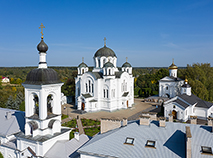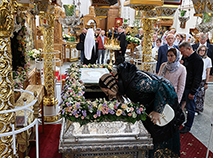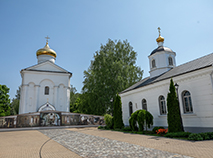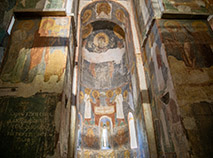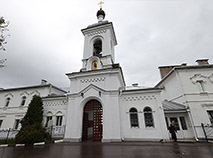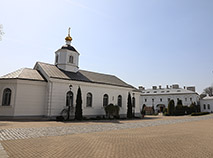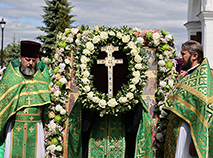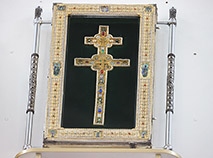St. Euphrosyne Convent in Polotsk

St. Euphrosyne Convent in Polotsk is a unique Orthodox monastery in Belarus, one of the oldest in Eastern Europe. It was founded by Euphrosyne of Polotsk, the first Belarusian saint, the heavenly intercessor of the country.
The convent of the Savior (Transfiguration) was founded in Polotsk in 1125. According to The Life of Euphrosyne of Polotsk, the young princess, who took monastic vows, had a recurring dream of an angel showing her the place of the future convent on the banks of the Polota River. The construction began soon afterwards. Years later it received the name of Euphrosyne.
Today it is the most famous center of Orthodoxy in Belarus, a place of pilgrimage for believers from all over the world, a monastery with a rich history, priceless relics and heritage of spiritual art.
Euphrosyne of Polotsk, the Saint of Belarusian Lands
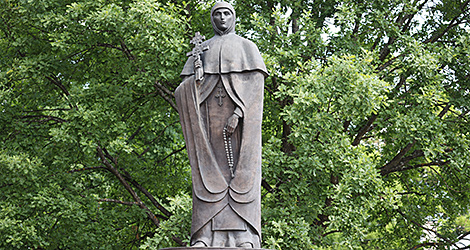
The woman, who was the first to be canonized in the Belarusian lands, was a unique personality of her time: a great ascetic, educator, and intercessor for the Belarusian people.
St. Euphrosyne initiated the first educational institutions and libraries in the Belarusian lands, the development of architecture, fine art traditions and crafts. She became famous not only as the patroness of women's monasticism but also as the founder of a men's monastery.
Euphrosyne lived in a difficult time of the appanage wars and made great efforts to reconcile the warring parties: "I do not want to see anyone at war. Neither a prince against a prince, a boyar against another boyar, or common people. I want everyone to live as one soul"…
Princess Predslava, the daughter of Prince Svyatoslav Vseslavich (Georgy in baptism) and the great-granddaughter of Holy Equal-to-the-Apostles Prince Vladimir, was born circa 1101. From her childhood she was noted for her love of prayer and book learning. At the age of 12, she resolutely rejected the marriage proposal and took monastic vows under the name Euphrosyne (“joy” in Greek).
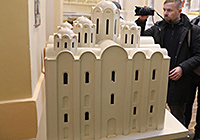
Having settled in St. Sophia Cathedral, the young nun kept the Polotsk Chronicle, copied books, which she sold and used the proceeds to help the destitute, collected a library, which later became a treasure trove of knowledge in the Eastern Slavic lands...
In her old age, St. Euphrosyne, together with her sister nun Eupraxia and brother David, set out on a pilgrimage. After venerating the holy things at Constantinople she arrived in Jerusalem where she concluded her earthly journey in the monastery of the Most Holy Theotokos on 23 May 1173.
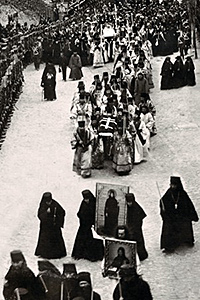
According to historians, no later than 1187, her body of was transferred to the Kiev Caves Lavra. Many centuries later, in 1871, Bishop Savva of Polotsk arranged for a part of her relics to be brought to the convent of the Savior (Transfiguration), and only in 1910 the remains of the saint were returned to her homeland.
A snow-white steamer decorated with flowers, carrying a reliquary with the relics of St. Euphrosyne, sailed along the Dnieper accompanied by two more ships with pilgrims, prominent religious and state figures. Divine services were held at the stops all the way from Kiev to Polotsk. At the piers, believers lit fires and candles, the flame of which was reflected in the water, giving even greater solemnity and beauty to prayer services. The relics that arrived in her hometown were laid to rest in the Savior and St. Euphrosyne Convent, which she had founded. Over the following years, they left Polotsk on several occasions, but from 1943 to the present day they have remained at the ancient convent.
History of Savior and St. Euphrosyne Convent
It is known that around 1125 Euphrosyne together with one of the nuns settled in a place called Seltso near Polotsk, where, with the blessing of Bishop Ilya, she founded a new convent "near the Church of the Savior".
Soon other young Polotsk women began to come here seeking salvation. Euphrosyne was soon joined by her sister Gordislava and her cousin Zvenislava (Eudoxia and Eupraxia in monasticism). Euphrosyne taught the nuns to copy books, singing, sewing and other handicrafts.
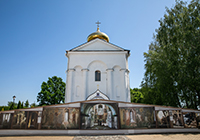
It was a wooden Church of the Savior and a stone church-burial vault of the Polotsk bishops. Later, on the instruction of Euphrosyne, architect Ioann erected the stone Transfiguration Church in 30 weeks on the site of the wooden church. The church has survived to this day. In the church the architect built two cross-shaped cells – for the nun herself and her sister, the nun Eudoxia.
One of the distinguishing features of the church was its fresco painting that was performed with incredible artistic skill. As of today, the 12-century frescoes of the Transfiguration Church are the oldest in Belarus. For a long time they were covered by another layer of paintings that were made in the 18th–19th centuries. However, starting from the 1990s, restorers have been bringing them back from oblivion: almost all of them have been uncovered, with the exception of the frescoes in the most inaccessible places of the building.
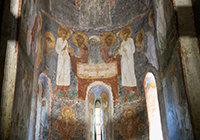
In 1161 Lazar Bogsha was commissioned by Euphrosyne of Polotsk to create a communion cross for the Transfiguration Church. The goldsmith used the cloisonné technique that was the preferred style of enameling in the Byzantine Empire. The cross was not only a splendid piece of jewelry, but it also became a priceless relic. The cross combined Christian relics - a particle of the Life-Giving Wood with a drop of the Blood of the Savior, a particle of the stone of the Holy Sepulcher, a particle of the stone of the Sepulcher of the Mother of God and particles of the relics of saints. “Honorable wood is priceless,” read the inscription on it.
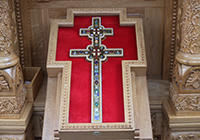
The relic was lost during the Great Patriotic War never to be found again. In 1997 Nikolai Kuzmich, a jeweler-enamel maker from Brest, recreated the Cross of Saint Euphrosyne: it took him five years to do it. The new relic was consecrated by Metropolitan Filaret, Patriarchal Exarch of All Belarus, and was first presented to the public at St. Simeon Cathedral of Brest. After this, the cross was transferred to the Transfiguration Church in St. Euphrosyne Convent.
Trivia! The Church of the Theotokos was erected not far from the convent of the Savior on the instructions of Euphrosyne around 1155. A men’s monastery was also built there. At Euphrosyne’s request, the Ephesian icon of the Theotokos was brought from Constantinople. A legend has it that it was painted by Holy Apostle and Evangelist Luke. Today this icon, given as a blessing for the marriage of Alexander Nevsky with Polotsk Princess Alexandra, is keptin the Alexander Nevsky Church in the village of Knyazhye Ozero, Moscow Metropolia. However, the Polotsk monastery of the Theotokos founded by Euphrosyne ceased to exist several centuries later.
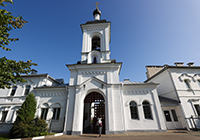
But the convent of the Savior has survived throughout the centuries! After the capture of Polotsk by the army of King Stephen Báthory the convent came into possession of the Jesuits (1580-1820, with a break in 1654-1667), and from 1820 to 1832 it was run by the Piarists.
In 1841, the Holy Synod issued a decree to revive the ancient convent near the Church of the Savior. In 1844 the St. Euphrosyne Women’s School was opened at the convent.
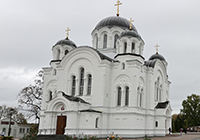
The convent started growing, becoming not only an important religious center, but also a beautiful architectural specimen. A new stone church was erected on the site of the dilapidated house church in 1847. The new church was consecrated in honor of St. Euphrosyne.
In 1897, the five-domed Holy Cross Cathedral rose above the convent. Contemporaries were delighted with its grandeur and elegant interior decoration that included paintings, ornamental iconostasis and mosaic floors made of marble and cement slabs.
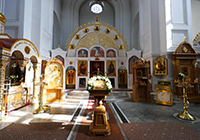
In 1910, the relics of the holy abbess were returned to the Savior and St. Euphrosyne Convent. They were delivered by steamship from Kiev to Orsha, and from Orsha they were solemnly carried by clergy, monks and ordinary believers to Polotsk along a roundabout route through Vitebsk.
During the First World War, the nuns and the relics of the convent were evacuated to the Avraam Monastery in Rostov, where they remained until 1921.
A difficult period began for the Polotsk convent after the revolution of 1917. Many of its relics were requisitioned. The convent was completely shut down in 1925. Its buildings were given to the military and other departments.
Polotsk was under the Nazi occupation during Great Patriotic War. During the years of difficult trials, people began to turn to God again, and in 1943, the occupation authorities gave permission to open the Polotsk convent.
In 1961, the Savior and St. Euphrosyne Convent was closed once again, and the nuns moved to the Zhirovichi Holy Assumption Monastery. The ancient Transfiguration Church remained the only functioning church in the city.
The convent of St. Euphrosyne was reopened in 1989-1990 and since then it has been the largest spiritual center of Orthodoxy in Belarus. The Cross of St. Euphrosyne, recreated by Nikolai Kuzmich, a jeweler from Brest, was brought to the convent in 1997. In 2007 the jeweler recreated the silver reliquary, using the photos of 1910.
Architectural ensemble
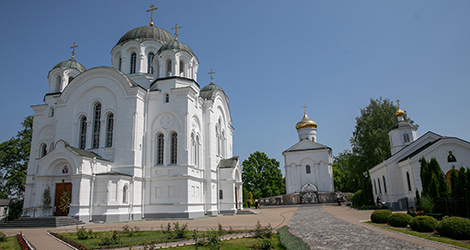
The Savior and St. Euphrosyne Convent is one of the first convents in Kievan Rus. Today this impressive ensemble is an architectural gem of the ancient city of Polotsk.
The convent complex features:
-
Transfiguration Church of the 12th century, built during the life of St. Euphrosyne and preserving unique ancient frescoes;
-
St. Euphrosyne (Warm) Church, rebuilt from a dilapidated house church into a stone one in 1847;
-
Holy Cross Cathedral, erected in 1893-1897;
-
a bell tower (a stone bell tower over the gates of the convent was built in 1882, but, most likely, was destroyed during the Great Patriotic War and rebuilt only in 1992 to celebrate the 1000th anniversary of the Polotsk diocese);
-
nuns’ premises and a dining hall;
-
outbuildings.
The convent complex also includes a spiritual and educational center, church shops, hotels for pilgrims, and a tea house.
Premises which have not survived included a church-vault of the 12th century (a cross was installed in its place), an old refectory (1902-1903), a summer fountain (early 20th century), and a chapel located 400m from the monastery (1897).
Convent shrines
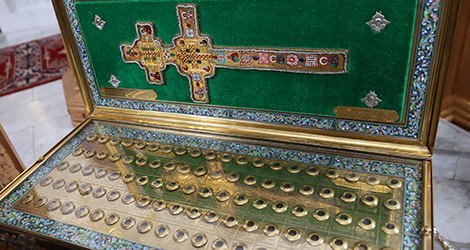
The Savior and St. Euphrosyne Convent in Polotsk hosts pilgrims from Belarus and different parts of the world every day. Many believers come here to worship the shrines. Among them are:
-
the holy relics of the founder of the convent, Euphrosyne of Polotsk;
-
the Cross of St. Euphrosyne of Polotsk (recreated in 1997);
-
a silver reliquary (recreated in 2007 according to the sketches of 1910);
-
the chains of St. Euphrosyne of Polotsk (found in 1991 in the ancient Church of the Savior);
-
two especially venerated lists of the Ephesian icon of the Mother of God (the first was created in the 16th century from the Polotsk wonderworking image of the 12th century, the second was made by iconographer N.G. Bogdanov in the Russian Museum of St. Petersburg from the original icon in 1992);
-
Krasnostok icon of the Mother of God (presumably of the 17th century);
-
other venerated icons (Holy Savior and St. Euphrosyne Convent keeps many icons from different periods, including those that were the property of the convent even before the 20th century; there are also modern icons painted by local nuns of the convent);
-
reliquaries (in addition to the relics of St. Euphrosyne, the convent keeps some 300 relics of saints).
Savior and St. Euphrosyne Convent today
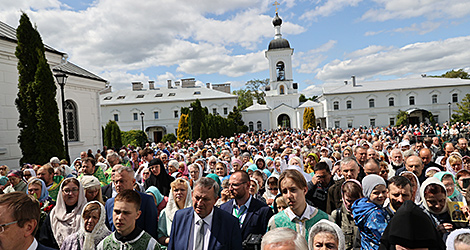
Mother Superior Evdokia (Levshuk) took charge of the Savior and St. Euphrosyne Convent in August 2004.
About 130 nuns live in the Savior and St. Euphrosyne Convent today. There are also staff members. The convent has a publishing house and an archive, convent and parish libraries, a Sunday school, an excursion service, workshops (icon painting, sewing, bookbinding), a choir, and a bakery.
Thousands of pilgrims come to worship St. Euphrosyne of Polotsk every year. The convent, as one of the main landmarks of Polotsk, attracts many tourists.
Celebrations to mark the 900th anniversary of the convent
In 2025 Belarus marks the 900th anniversary of the Savior-St Euphrosyne Stavropegic Convent in Polotsk. The celebration program is extensive and diverse, with the key events taking place in the homeland of Saint Euphrosyne on 4-5 June.
Built in the 12th century, this is one of Eastern Europe’s oldest surviving convents. Events dedicated to the anniversary are being held in the convent, in the Polotsk diocese, and throughout Belarus during the year.
In January, the unique Savivor-Transfigiraton Church of the Savior-St Euphrosyne Stavropegic Convent was reopened after many years of restoration. This temple is one of Belarus’ most ancient places of worship made of stone. During the restoration effort, many frescoes dating back to the 12th century were discovered. They covered 90% of the walls.
The documentary The Abode of Saint Euphrosyne premiered in February. It tells about the life and exploits of the heavenly patroness of the Belarusian land, Saint Euphrosyne of Polotsk, as well as the daily life of the convent in the present day.
Where is the Savior and St. Euphrosyne Convent located?
Address: 89 Evfrosiniya Polotskaya St., Polotsk, Vitebsk Oblast
Attractions near the Savior and St. Euphrosyne Convent
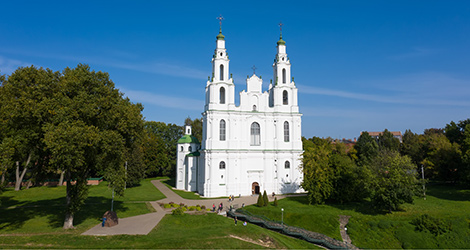
The convent is located in Belarus’ most ancient city - Polotsk. For many centuries the city has been famous for its churches and monasteries, unique architectural traditions, outstanding people, whose names are still closely associated with the city’s iconic places.
The other sights of Polotsk include:
-
Museum of Belarusian Book Printing and other museums of Polotsk;
-
Polotsk – Europe’s Geographical Center sign;
-
Monument to the Belarusian letter Ў;
-
Polotsk Jesuit Collegium, where visitors can address questions to the Mechanical Head, a reconstruction of the famous creation of the 18th-century scientist Gabriel Gruber;
-
Nizhne-Pokrovskaya Street is a street full of old houses and museums;
-
monuments to prominent natives – Euphrosyne of Polotsk, Francysk Skaryna, Simeon of Polotsk.


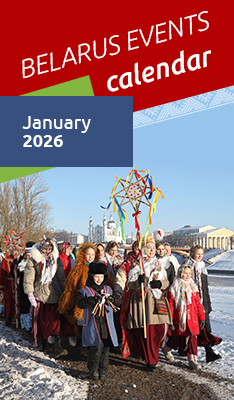




 print version
print version make home page
make home page add to bookmarks
add to bookmarks